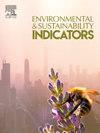中国资源型城市生态福祉绩效变化:损失成因与驱动因素
IF 5.6
Q1 ENVIRONMENTAL SCIENCES
引用次数: 0
摘要
探讨中国资源型城市生态福祉绩效损失的成因和驱动因素,可为推动城市高质量发展提供政策参考。利用GB-US-EBM模型,对2011 - 2022年中国114个资源型城市的生态福祉绩效(EWP)进行测度,对生态福祉绩效的构成要素进行分解,并找出绩效损失的根源。此外,将指数分解分析(IDA)恒等式与对数平均可分指数(LMDI)分解方法相结合,探讨了驱动EWP动态变化的因素。结果表明:①2011 - 2022年,资源型城市年平均环境生产总值为0.347,年均增长0.33%;增长型城市EWP最高,递减型城市次之,成熟型城市次之,再生型城市次之。(2)在系统效率的转换中,增长型、衰退型和再生型城市的生态经济效率高于经济福利效率。(3)性能损失主要是由不同程度的输入冗余和输出不足引起的。(4)从外部驱动因素来看,EWP由负向正的转变主要受经济发展、技术研发、产业结构优化和污染物排放强度降低的驱动。基于此,中国资源型城市应优先发展公益性基础设施,加强公共服务和社会保障体系建设,加快绿色转型和经济结构调整。本文章由计算机程序翻译,如有差异,请以英文原文为准。
Exploring the changes in ecological well-being performance of resource-based cities in China: Origins of loss and driving factors
Exploring the origins and drivers of ecological well-being performance loss in China's resource-based cities can provide policy references for promoting high-quality urban development. Using the GB-US-EBM model, this study measures the ecological well-being performance (EWP) of 114 resource-based cities in China from 2011 to 2022, disaggregates the components of EWP, and identifies the origins of performance loss. Additionally, the study integrates the index decomposition analysis (IDA) identity with the logarithmic mean divisia index (LMDI) decomposition approach to investigate the factors driving dynamic changes in EWP. The key findings are as follows: (1) From 2011 to 2022, the average annual EWP across all resource-based cities was 0.347, increasing at an average annual rate of 0.33%. Growing cities exhibited the highest EWP, followed in descending order by declining cities, mature cities, and regenerating cities. (2) In the transformation of system efficiencies, growing, declining, and regenerating cities exhibited higher eco-economic efficiency than economic welfare efficiency. (3) Performance loss is primarily attributable to varying levels of input redundancy and output shortfalls. (4) In terms of external drivers, the shift in EWP from negative to positive was primarily driven by economic development, technological research and development, optimization of industrial structure, and reduction of pollutant emission intensity. Based on these findings, resource-based cities in China should prioritize the development of public welfare infrastructure, enhance public services and social security systems, and accelerate green transformation and economic restructuring.
求助全文
通过发布文献求助,成功后即可免费获取论文全文。
去求助
来源期刊

Environmental and Sustainability Indicators
Environmental Science-Environmental Science (miscellaneous)
CiteScore
7.80
自引率
2.30%
发文量
49
审稿时长
57 days
 求助内容:
求助内容: 应助结果提醒方式:
应助结果提醒方式:


